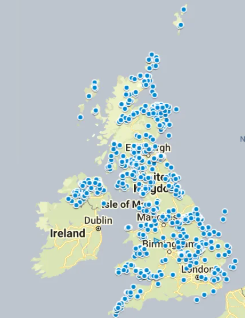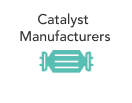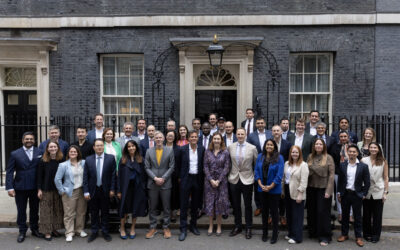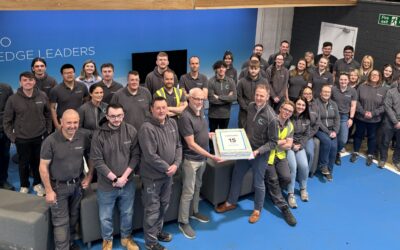Written By Ralph Lavery, Net Zero Applications Engineer
Aviation is an engineering marvel, but the world has changed…
In 1903, two American bicycle mechanics, brothers Wilbur and Orville Wright, changed the world by achieving the first ever controlled and powered flight. Their 12-second flight over 120 feet wasn’t just a technical feat, it was the birth of modern aviation (1).
Just 11 years later, the first commercial flight carried passengers across Florida (2), laying the foundation for an industry that now moves over 5 billion people a year (3).
Aviation has become essential to global connection, logistics, defence, and business, however, as industries have grown, so have carbon emissions. The earth is now warming at an alarming rate, and we have mere years until the damage is irreversible. Aviation now faces an urgent challenge: how to scale safely, meet soaring fuel demand, and decarbonise.
Alternatives like batteries or hydrogen aren’t yet viable for most aircraft due to energy density and safety constraints. Sustainable Aviation Fuel (SAF) remains the only scalable pathway for decarbonising both existing and future fleets.
Yet the existing SAF model relies on centralised supply chains with some still utilising fossil fuel in their production process of SAF – which is counterintuitive for carbon intensity.
That’s where ClimaHtech Green Flight offers a game-changing alternative, delivering modular, decentralised SAF production to meet aviation’s decarbonisation challenge head-on.
The problem with conventional fuel models
Traditional fuel production has been developed over decades, in large, highly concentrated, complex plants that take crude oil and produce a range of different petrochemicals including fuels. These complex sites are enormous, have highly complex safety, permitting, and planning, and require significant supporting infrastructure, particularly transport and electricity networks.
For example, an average mid-sized refinery by global standards can occupy an area larger than Heathrow Airport and require extensive supporting infrastructure. Such a facility might have an output of around 380,000 barrels per day.

Figure 1 – One of the Largest Oil Refineries in the World
Developing new fuel producing plants like this takes a long time, typically 5 years from breaking ground, and usually requires creation of dedicated supporting infrastructure such as transport and electricity networks. In recent years, local power generation is also needed as well as upgrades to road, rail, or marine transport infrastructure to accommodate the volumes of people, fuel, and feedstocks moving to and through these sites every day.
This means that increasing fuel production capacity using traditional, large-scale technology such as refineries takes a long time (and a lot of money) before any SAF is produced. It also requires significant investment in electricity and transportation networks to support these large facilities.
All of this must happen in 5 years or less to meet 2030 mandated targets in the UK and EU, a seriously challenging timeline for conventional technologies. Failure to decarbonise aviation and other industries will drastically hamper our ability to limit global average warming to the 1.5 ˚C limit set out in the Paris Agreement.
ClimaHtech Green Flight – The Decentralised Net Zero
ClimaHtech Green Flight take an alternative approach focused on decentralised SAF production, designed to be deployed faster, closer to renewable sources, and with far less infrastructure burden.
Why it matters:
- Faster Deployment: Smaller, modular systems reduce installation time.
- Less grid strain: Built to operate alongside intermittent renewables, utilising energy that might otherwise be curtailed or lost through constraint.
- Local demand creation: The system can turn surplus renewable electricity into fuel, helping to maximise local resource use.
How it works:
- Powered by CATAGEN’s OMEGA e‑reactor, which is engineered for compatibility with renewable electricity. It excels under variable supply and captures energy that might be lost elsewhere.
- Located near renewable generation allowing production sites to avoid costly grid upgrades and lengthy electricity transmission.
- Fabricated using industry-standard components, enabling rapid deployment without the need for extensive site groundwork or custom infrastructure.
Distributed Renewables Need Decentralised Technology
As of April 2024, the UK had approximately 800 wind farms including nearly 10,000 onshore turbines with a total operational capacity of over 15.8GW. This means an ‘average’ wind farm produces 1.6 MW, and offshore farms which tend to be bigger average around 5.6 MW per turbine. Despite delivering around 29% of the country’s electricity, over half of these farms have capacities under 10 MW, making them incompatible with large-scale, centralised fuel plants. (5)
Most existing refineries and fuel depots require 100+ MW inputs, scales that don’t match the majority of renewables. As a result, many wind assets regularly export excess power or face curtailment due to grid limitations, especially in rural or offshore locations (6).

This mismatch underscores why CATAGEN’s decentralised SAF model is so essential:
- It enables modular SAF production directly co-located with renewable power, reducing the amount of electricity that is constrained.
- It adds local demand for excess electricity, allowing intermittent renewables to be better utilised.
- It can be deployed rapidly, without costly grid upgrades or long-distance power transmission.
Decentralised production helps convert underutilised renewable energy into SAF, turning a grid bottleneck into an active driver of clean fuel innovation and continued renewable expansion.
Building Resilient Local Energy Economies
Decentralised SAF production enables regions to turn their own renewable energy into low-carbon fuel, which unlocks energy generation in areas without access to oil and gas infrastructure.
This approach supports:
- Regional energy independence, reducing reliance on global fuel supply chains
- Greater energy security, especially important amid growing geopolitical tensions and fuel market volatility
- Economic resilience, as more value is retained locally through domestic fuel production
In the UK and across Europe, where conventional refineries face mounting economic and regulatory challenges, decentralised systems offer a future-ready alternative. While not a complete replacement for all fuel imports, it’s a critical step toward building a more secure, stable, and sustainable energy mix.
The Future of SAF is Diverse — and Decentralised
To meet the ambitious SAF mandates set by the UK, EU, and beyond, we need a broad portfolio of solutions. All approved SAF pathways have a vital role to play in decarbonising aviation at scale.
ClimaHtech Green Flight have identified decentralised production as a key enabling factor. Much like how the energy transition has seen a shift from centralised generation to distributed solar and wind, liquid fuel production can benefit from a similar transformation.
The decentralised model opens the door to new collaborations, between fuel producers, renewable generators, airports, and airlines, to create resilient, local energy economies that reduce dependency on imported fuels.
ClimaHtech Green Flight is designed for this future. Our modular, electrified SAF production system is engineered to complement existing efforts, accelerate deployment, and help scale SAF production where it’s needed most.
A collaborative, diversified approach is essential, and decentralisation is a powerful part of the solution.
Join the movement towards a decentralised SAF future.
Sign up for our digital launch and discover how ClimaHtech Green Flight can accelerate aviation’s net zero journey through decentralised SAF production.

About Ralph:
Ralph Lavery is Head of Technology Applications at ClimaHtech Green Flight and brings substantial expertise in the development and delivery of techno-economic and pre-FEED studies across hydrogen and hydrogen derivative applications.
He is also highly skilled in commercial and business model development for emerging net zero technologies, as well as market segment analysis and assessment. He is currently leading the commercialisation aspects of ClimaHtech Green Flight, bringing disruptive SAF production to the market.
PRESS RELEASE: CATAGEN Named UK’s Number 1 Most Innovative Green Technology Firm for 2025 by BusinessCloud
CATAGEN Places Number 1 in BusinessCloud’s EnviroTech 50 for 2025. EnviroTech 50 is an annual...
Voices for Change #4: Could Our Winters Turn Baltic? Exploring the Future of the Gulf Stream by Prof. Roy Douglas
Should we be worried about the future of the Gulf Stream? CATAGEN’s CSO and Co-Founder Roy Douglas...
Blog: Powering Progress – Biofuels and E-Fuels in the Marine Sector
By Kurtis Irwin, VP of Global Catalysis As global climate goals tighten and regulatory pressures...
PRESS RELEASE: CATAGEN Makes the Top 500 List of Fastest Growing Technology Companies in EMEA
CATAGEN, a Net Zero technologies company, has been listed on The Deloitte Fast 500 list for...
PRESS RELEASE: CATAGEN Selected for Tech Nation’s Future Fifty 2025 Cohort
7 MAY – LONDON. CATAGEN, a leader in green emissions testing and net zero technologies, is...
CATAGEN Celebrates 15 Year Anniversary
Yesterday CATAGEN celebrated its 15 year anniversary of its founding day. This week, the CATAGEN...


















